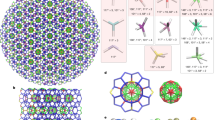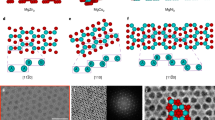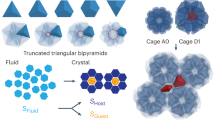Abstract
Icosahedral quasicrystals (IQCs) are a form of matter that is ordered but not periodic in any direction. All reported IQCs are intermetallic compounds and either of face-centred-icosahedral or primitive-icosahedral type, and the positions of their atoms have been resolved from diffraction data. However, unlike axially symmetric quasicrystals, IQCs have not been observed in non-atomic (that is, micellar or nanoparticle) systems, where real-space information would be directly available. Here, we show that an IQC can be assembled by means of molecular dynamics simulations from a one-component system of particles interacting via a tunable, isotropic pair potential extending only to the third-neighbour shell. The IQC is body-centred, self-assembles from a fluid phase, and in parameter space neighbours clathrates and other tetrahedrally bonded crystals. Our findings elucidate the structure and dynamics of the IQC, and suggest routes to search for it and design it in soft matter and nanoscale systems.
This is a preview of subscription content, access via your institution
Access options
Subscribe to this journal
Receive 12 print issues and online access
$259.00 per year
only $21.58 per issue
Buy this article
- Purchase on Springer Link
- Instant access to full article PDF
Prices may be subject to local taxes which are calculated during checkout





Similar content being viewed by others
References
Caspar, D. L. D. & Klug, A. Physical principles in the construction of regular viruses. Cold Spring Harb. Symp. Quant. Biol. 27, 1–24 (1962).
Schenk, T., Holland-Moritz, D., Simonet, V., Bellissent, R. & Herlach, D. M. Icosahedral short-range order in deeply undercooled metallic melts. Phys. Rev. Lett. 89, 075507 (2002).
Hirata, A. et al. Geometric frustration of icosahedron in metallic glasses. Science 341, 376–379 (2013).
Wales, D. J. & Doye, J. P. K. Global optimization by basin-hopping and the lowest energy structures of Lennard-Jones clusters containing up to 110 atoms. J. Phys. Chem. A 101, 5111–5116 (1997).
Hubert, H. et al. Icosahedral packing of B12 icosahedra in boron suboxide (B6O). Nature 391, 376–378 (1998).
de Nijs, B. et al. Entropy-driven formation of large icosahedral colloidal clusters by spherical confinement. Nature Mater.http://dx.doi.org/10.1038/nmat4072 (2014)
Shechtman, D., Blech, I., Gratias, D. & Cahn, J. W. Metallic phase with long-range orientational order and no translational symmetry. Phys. Rev. Lett. 53, 1951–1953 (1984).
Levine, D. & Steinhardt, P. J. Quasicrystals: A new class of ordered structures. Phys. Rev. Lett. 53, 2477–2480 (1984).
Man, W., Megens, M., Steinhardt, P. J. & Chaikin, P. M. Experimental measurement of the photonic properties of icosahedral quasicrystals. Nature 436, 993–996 (2005).
Dubois, J-M. Properties and applications of quasicrystals and complex metallic alloys. Chem. Soc. Rev. 41, 6760–6777 (2012).
Tsai, A-P. Discovery of stable icosahedral quasicrystals: Progress in understanding structure and properties. Chem. Soc. Rev. 42, 5352–5365 (2013).
Bindi, L., Steinhardt, P. J., Yao, N. & Lu, P. J. Natural quasicrystals. Science 324, 1306–1309 (2009).
Takakura, H., Gómez, C. P., Yamamoto, A., De Boissieu, M. & Tsai, A. P. Atomic structure of the binary icosahedral Yb–Cd quasicrystal. Nature Mater. 6, 58–63 (2007).
Yamamoto, A. Crystallography of quasiperiodic crystals. Acta Crystallogr. A 52, 509–560 (1996).
Steurer, W. & Deloudi, S. Crystallography of Quasicrystals: Concepts, Methods and Structures (Springer Series in Materials Science, 2009).
Quiquandon, M. & Gratias, D. About the atomic structures of icosahedral quasicrystals. C. R. Phys. 15, 18–29 (2014).
Rokhsar, D. S., Mermin, N. D. & Wright, D. C. Rudimentary quasicrystallography: The icosahedral and decagonal reciprocal lattices. Phys. Rev. B 35, 5487–5495 (1987).
Edagawa, K., Suzuki, K. & Takeuchi, S. High resolution transmission electron microscopy observation of thermally fluctuating phasons in decagonal Al–Cu–Co. Phys. Rev. Lett. 85, 1674–1677 (2000).
De Boissieu, M., Francoual, S., Kaneko, Y. & Ishimasa, T. Diffuse scattering and phason fluctuations in the Zn–Mg–Sc icosahedral quasicrystal and its Zn–Sc periodic approximant. Phys. Rev. Lett. 95, 105503 (2005).
Zeng, X. et al. Supramolecular dendritic liquid quasicrystals. Nature 428, 157–160 (2004).
Talapin, D. V. et al. Quasicrystalline order in self-assembled binary nanoparticle superlattices. Nature 461, 964–967 (2009).
Xiao, C., Fujita, N., Miyasaka, K., Sakamoto, Y. & Terasaki, O. Dodecagonal tiling in mesoporous silica. Nature 487, 349–353 (2012).
Dzugutov, M. Formation of a dodecagonal quasicrystalline phase in a simple monatomic liquid. Phys. Rev. Lett. 70, 2924–2927 (1993).
Haji-Akbari, A. et al. Disordered, quasicrystalline and crystalline phases of densely packed tetrahedra. Nature 462, 773–777 (2009).
Iacovella, C. R., Keys, A. S. & Glotzer, S. C. Self-assembly of soft-matter quasicrystals and their approximants. Proc. Natl Acad. Sci. USA 108, 20935–20940 (2011).
Dmitrienko, V. E. & Astaf’ev, S. B. Oscillating interatomic potentials and growth of icosahedral quasicrystals. Phys. Rev. Lett. 75, 1538–1541 (1995).
Dmitrienko, V. E., Astaf’ev, S. B. & Kléman, M. Monte Carlo simulations of icosahedral quasicrystal growth and melting. Phys. Rev. B 59, 286–293 (1999).
Engel, M. & Trebin, H-R. Self-assembly of monatomic complex crystals and quasicrystals with a double-well interaction potential. Phys. Rev. Lett. 98, 225505 (2007).
Dotera, T., Oshiro, T. & Ziherl, P. Mosaic two-lengthscale quasicrystals. Nature 506, 208–211 (2014).
Trambly de Laissardière, G., Nguyen-Manh, D. & Mayou, D. Electronic structure of complex Hume-Rothery phases and quasicrystals in transition metal aluminides. Prog. Mater. Sci. 50, 679–788 (2005).
Elenius, M., Zetterling, F. H. M., Dzugutov, M., Fredrickson, D. C. & Lidin, S. Structural model for octagonal quasicrystals derived from octagonal symmetry elements arising in β-Mn crystallization of a simple monatomic liquid. Phys. Rev. B 79, 144201 (2009).
Mihalkovič, M. & Henley, C. L. Empirical oscillating potentials for alloys from ab initio fits and the prediction of quasicrystal-related structures in the Al–Cu–Sc system. Phys. Rev. B 85, 092102 (2012).
Rechtsman, M. C., Stillinger, F. H. & Torquato, S. Synthetic diamond and wurtzite structures self-assemble with isotropic pair interactions. Phys. Rev. E 75, 1–7 (2007).
Jain, A., Errington, J. R. & Truskett, T. M. Inverse design of simple pairwise interactions with low-coordinated 3D lattice ground states. Soft Matter 9, 3866–3870 (2013).
Barkan, K., Engel, M. & Lifshitz, R. Controlled self-assembly of periodic and aperiodic cluster crystals. Phys. Rev. Lett. 113, 098304 (2014).
Keys, A. S. & Glotzer, S. C. How do quasicrystals grow? Phys. Rev. Lett. 99, 235503 (2007).
Steurer, W. On a realistic growth mechanism for quasicrystals. Z. Anorg. Allg. Chem. 637, 1943–1947 (2011).
Achim, C. V., Schmiedeberg, M. & Löwen, H. Growth modes of quasicrystals. Phys. Rev. Lett. 112, 255501 (2014).
Crain, J. et al. Theoretical study of high-density phases of covalent semiconductors. I. Ab initio treatment. Phys. Rev. B 49, 5329–5340 (1994).
Shoemaker, D. P. & Shoemaker, C. B. Concerning the relative numbers of atomic coordination types in tetrahedrally close packed metal structures. Acta Crystallogr. B 42, 3–11 (1986).
Gryko, J. et al. Low-density framework form of crystalline silicon with a wide optical band gap. Phys. Rev. B 62, R7707–R7710 (2000).
Jacobson, L. C., Hujo, W. & Molinero, V. Thermodynamic stability and growth of guest-free clathrate hydrates: A low-density crystal phase of water. J. Phys. Chem. B 113, 10298–10307 (2009).
Ma, Y., Oganov, A. R. & Xie, Y. High-pressure structures of lithium, potassium, and rubidium predicted by an ab initio evolutionary algorithm. Phys. Rev. B 78, 014102 (2008).
Takeda, Y., Kanamura, F., Shimada, M. & Koizumi, M. The crystal structure of BaNiO3 . Acta Crystallogr. B 32, 2464–2466 (1976).
Ishii, Y. Propagating local positional order in tetrahedrally bonded systems. Acta Crystallogr. A 44, 987–998 (1988).
Peters, J. & Trebin, H-R. Tetracoordinated quasicrystals. Phys. Rev. B 43, 1820–1823 (1991).
Dmitrienko, V. E. & Kléman, M. Tetrahedral structures with icosahedral order and their relation to quasicrystals. Crystallogr. Rep. 46, 527–533 (2001).
Bergman, G., Waugh, J. L. T. & Pauling, L. The crystal structure of the metallic phase Mg32(Al, Zn)49. Acta Crystallogr. 10, 254–259 (1957).
Macfarlane, R. J., Jones, M. R., Lee, B., Auyeung, E. & Mirkin, C. A. Topotactic interconversion of nanoparticle superlattices. Science 341, 1222–1225 (2013).
Auyeung, E. et al. DNA-mediated nanoparticle crystallization into Wulff polyhedra. Nature 505, 73–77 (2014).
Johnston, J. C., Kastelowitz, N. & Molinero, V. Liquid to quasicrystal transition in bilayer water. J. Chem. Phys. 133, 154516 (2010).
Johnston, J. C., Phippen, S. & Molinero, V. A single-component silicon quasicrystal. J. Phys. Chem. Lett. 2, 384–388 (2011).
Anderson, J. A., Lorenz, C. D. & Travesset, A. General purpose molecular dynamics simulations fully implemented on graphics processing units. J. Comput. Phys. 227, 5342–5359 (2008).
Anderson, J. A. & Glotzer, S. C. The development and expansion of HOOMD-blue through six years of GPU proliferation. Preprint at http://arXiv.org/abs/1308.5587 (2013)
Acknowledgements
This material is based on work supported in part by the DOD/ASD(R&E) under Award No. N00244-09-1-0062 (M.E. and S.C.G.), by the US Army Research Office under Grant Award No. W911NF-10-1-0518 (S.C.G.), by the University of Michigan CEMRI for Photonics and Multiscale Nanomaterials (C-PHOM) funded by the National Science Foundation Materials Research Science and Engineering Center program DMR 1120923 (P.F.D.), and by a Simons Investigator award from the Simons Foundation to S.C.G. Simulations were performed on a GPU cluster managed by the University of Michigan’s Center for advanced computing and also on resources of the Argonne Leadership Computing Facility at Argonne National Laboratory, which is supported by the Office of Science of the US Department of Energy under contract DE-AC02-06CH11357 (C.L.P.). C.L.P. was funded by the Office of the Director through the Named Postdoctoral Fellowship Program (Aneesur Rahman Postdoctoral Fellowship), Argonne National Laboratory. Any opinions, findings, and conclusions or recommendations expressed in this publication are those of the authors and do not necessarily reflect the views of the DOD/ASD(R&E).
Author information
Authors and Affiliations
Contributions
All authors participated in the interaction potential design and the simulation set-up. M.E. performed data analysis of simulation results and studies of the larger configurations. P.F.D. and C.L.P. carried out numerical explorations of parameter space. S.C.G. coordinated and supervised the work. All authors contributed to the preparation of the manuscript.
Corresponding authors
Ethics declarations
Competing interests
The authors declare no competing financial interests.
Supplementary information
Supplementary Information
Supplementary Information (PDF 18199 kb)
Supplementary Information
Supplementary Information (HTML 1311 kb)
Rights and permissions
About this article
Cite this article
Engel, M., Damasceno, P., Phillips, C. et al. Computational self-assembly of a one-component icosahedral quasicrystal. Nature Mater 14, 109–116 (2015). https://doi.org/10.1038/nmat4152
Received:
Accepted:
Published:
Issue Date:
DOI: https://doi.org/10.1038/nmat4152
This article is cited by
-
A columnar liquid quasicrystal with a honeycomb structure that consists of triangular, square and trapezoidal cells
Nature Chemistry (2023)
-
How to design an icosahedral quasicrystal through directional bonding
Nature (2021)
-
Designing disorder into crystalline materials
Nature Reviews Chemistry (2020)
-
Phase Behaviors of Soft-core Particle Systems
Chinese Journal of Polymer Science (2019)
-
Forming quasicrystals by monodisperse soft core particles
Nature Communications (2017)



